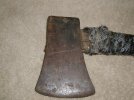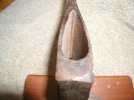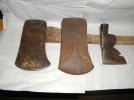The stamp is gone already as far as any value is concerned. Clean it up and make it a great user.
Thanks Square, I'm lucky that I could save it from the smelter mostly found down here are Michigan's and I'm guessing that it's ether a Jersey or Connecticut and my first, let alone a Mann Gold Bond and still seems to have a lot of life still in it 3# 5oz.




















